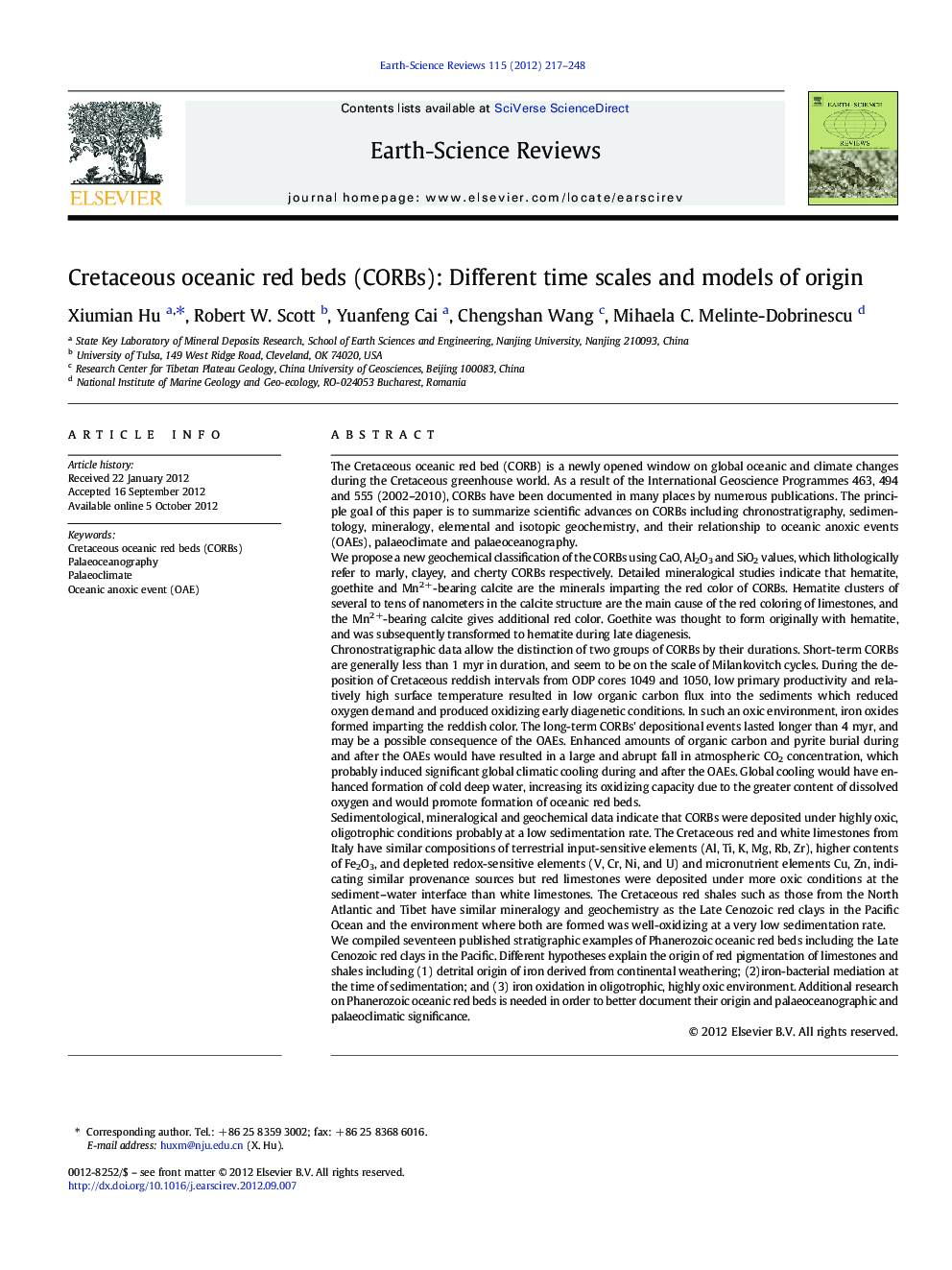| کد مقاله | کد نشریه | سال انتشار | مقاله انگلیسی | نسخه تمام متن |
|---|---|---|---|---|
| 4725912 | 1356066 | 2012 | 32 صفحه PDF | دانلود رایگان |

The Cretaceous oceanic red bed (CORB) is a newly opened window on global oceanic and climate changes during the Cretaceous greenhouse world. As a result of the International Geoscience Programmes 463, 494 and 555 (2002–2010), CORBs have been documented in many places by numerous publications. The principle goal of this paper is to summarize scientific advances on CORBs including chronostratigraphy, sedimentology, mineralogy, elemental and isotopic geochemistry, and their relationship to oceanic anoxic events (OAEs), palaeoclimate and palaeoceanography.We propose a new geochemical classification of the CORBs using CaO, Al2O3 and SiO2 values, which lithologically refer to marly, clayey, and cherty CORBs respectively. Detailed mineralogical studies indicate that hematite, goethite and Mn2 +-bearing calcite are the minerals imparting the red color of CORBs. Hematite clusters of several to tens of nanometers in the calcite structure are the main cause of the red coloring of limestones, and the Mn2 +-bearing calcite gives additional red color. Goethite was thought to form originally with hematite, and was subsequently transformed to hematite during late diagenesis.Chronostratigraphic data allow the distinction of two groups of CORBs by their durations. Short-term CORBs are generally less than 1 myr in duration, and seem to be on the scale of Milankovitch cycles. During the deposition of Cretaceous reddish intervals from ODP cores 1049 and 1050, low primary productivity and relatively high surface temperature resulted in low organic carbon flux into the sediments which reduced oxygen demand and produced oxidizing early diagenetic conditions. In such an oxic environment, iron oxides formed imparting the reddish color. The long-term CORBs' depositional events lasted longer than 4 myr, and may be a possible consequence of the OAEs. Enhanced amounts of organic carbon and pyrite burial during and after the OAEs would have resulted in a large and abrupt fall in atmospheric CO2 concentration, which probably induced significant global climatic cooling during and after the OAEs. Global cooling would have enhanced formation of cold deep water, increasing its oxidizing capacity due to the greater content of dissolved oxygen and would promote formation of oceanic red beds.Sedimentological, mineralogical and geochemical data indicate that CORBs were deposited under highly oxic, oligotrophic conditions probably at a low sedimentation rate. The Cretaceous red and white limestones from Italy have similar compositions of terrestrial input-sensitive elements (Al, Ti, K, Mg, Rb, Zr), higher contents of Fe2O3, and depleted redox-sensitive elements (V, Cr, Ni, and U) and micronutrient elements Cu, Zn, indicating similar provenance sources but red limestones were deposited under more oxic conditions at the sediment–water interface than white limestones. The Cretaceous red shales such as those from the North Atlantic and Tibet have similar mineralogy and geochemistry as the Late Cenozoic red clays in the Pacific Ocean and the environment where both are formed was well-oxidizing at a very low sedimentation rate.We compiled seventeen published stratigraphic examples of Phanerozoic oceanic red beds including the Late Cenozoic red clays in the Pacific. Different hypotheses explain the origin of red pigmentation of limestones and shales including (1) detrital origin of iron derived from continental weathering; (2)iron-bacterial mediation at the time of sedimentation; and (3) iron oxidation in oligotrophic, highly oxic environment. Additional research on Phanerozoic oceanic red beds is needed in order to better document their origin and palaeoceanographic and palaeoclimatic significance.
Journal: Earth-Science Reviews - Volume 115, Issue 4, December 2012, Pages 217–248